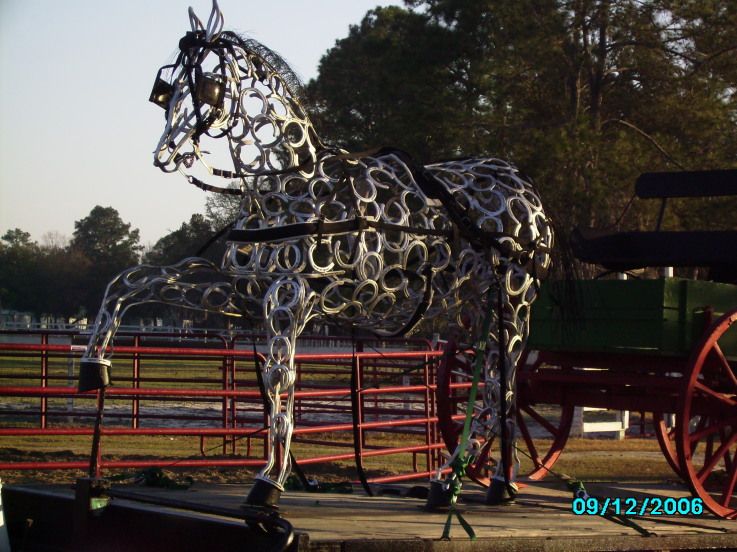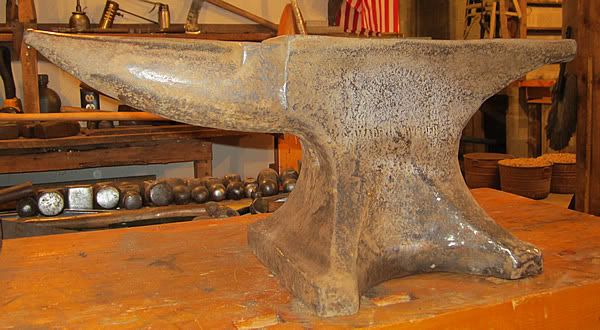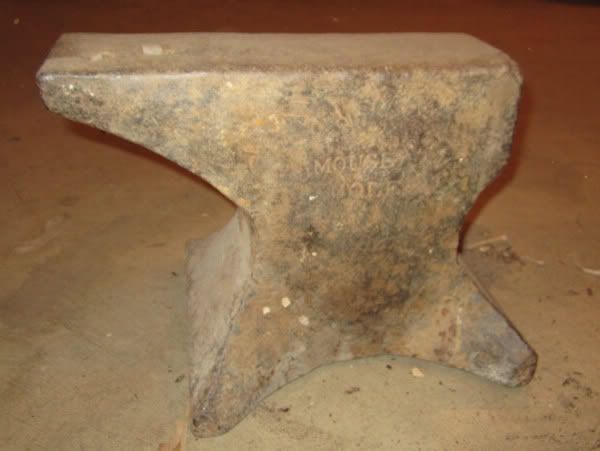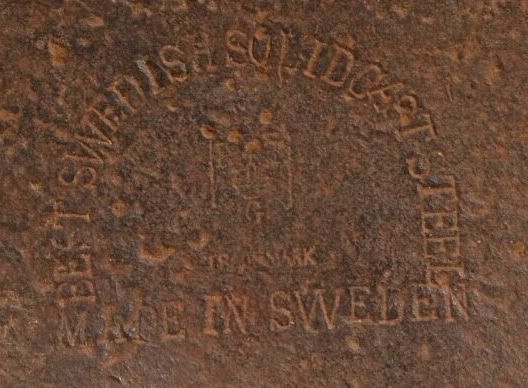-
Posts
272 -
Joined
-
Last visited
Content Type
Profiles
Forums
Articles
Gallery
Downloads
Events
Posts posted by DKForge
-
-
My mentor, a farrier and blacksmith for over 40 years made this.

-
I finally found the old building I am going to use for my shop. Now I need to decide where to put it on my property. My dilema is where I would like to put it is upwind from our garden, grape vines and berry bushes. Anyone have their shop near their garden, berries, or fruit trees and have you seen any side effects from that. I realize most of the coal smoke will be going up and over but was just wondering what you thought.
Thanks and I will post photos of the shop when it is up. -
Thanks to Sask Mark for helping to ID this anvil. He said Anvils In America has an anvil with this side stamp that is a Soderfors. It is 112# and rings like a bell. Good Swedish steel. It has steps on the front and back feet which led me to believe it was a Peter Wright before I saw the word Sweden appear from beneath years of rust as I was cleaning it up. I love cleaning up rusty steel you never know what you will find.

This one is a Mousehole that lost its horn somewhere along the way. It still weighs 120# without the missing appendage.
$125 for the pair makes that around $0.53 per lb. Not too shabby.
D- -
Anyone know what company used this marking on their anvils?
I picked up a 112# anvil with this mark on the side. It is not this clear but it is the same. Where I found this picture there was no name associated with that anvil either.
Thanks
D-
-
Joshua that actually does not look bad for a start. With the walls you have stacking straw bales behind should really help insulate your area. An inexpensive wall structure could be used pallets and then with the straw around the outside would give you the insulation and hide the pallets from any of dads clients. If he is training horses you could make some good money forging horseshoes into items and having them for sale. Helps to pay for new tools, better walls etc.
Good luck and keep at it! -
I know a treadle hammer does not a power hammer, striker, or fly press replace but would that be another alternative for kraythe? I would think it would be quieter to keep the neighbors happy and less expensive. I have never used one so I am just throwing it out there for others to jump in who have.
-
Hey stewartthesmith that sounds like an awesome opportunity to learn from someone with a legacy like the Russian you learned from. I can just imagine the stories that have been passed down in his family with that type of history.
Your point about "new technique...being invented" is exactly part of the point of my original post. I am always fascinated when something "new" is presented that in fact has been documented as being used in previous times and I just ponder how many of those type of techniques were lost in regions of the world where the industrial revolution sliced the generational line of smithing your Russian teacher was lucky enough to have intact.
On a side note I grew up and still have most of the family in PA so hopefully some day we can have a chance to meet and share stories of our own. -
Does anyone know the earliest written record of blacksmithing technique?
One of my favorite pastimes is looking at old archived photos of blacksmiths and farriers and their shops. I often wonder what techniques or processes may have been used years ago that have been lost due to no written record. The old photos give a glimpse into the shops and what they had in them, how they were setup etc but what about even before photography, prior to late 1800's.
I know we can look at items in museums and in collections and we can guess at how they were made but without a written record they are in some cases just guesses. I was just wondering if anyone can give some examples of the earliest written descriptions you may have come across.
Thanks -
William Fosters are fascinating anvils since there is not a lot known about them compared to other makers of the time. I have a #109 WF dated 1851 with a crown and the letters JP at the bottom and a #212 WF dated 1854 with crowns and a letter B at the bottom. I had read somewhere that the letters at the bottom were the inspector marks from when they were made.
-
Chalky very nicely done! One of the nicest I have seen.
D- -
I tend to agree with the correlation between amount spent and longevity in the craft. I think the spirit of blacksmithing that prevails within most of us revolves around the desire to do it ourselves whether it be scrounging for steel, making a forge, your own hammer, tongs and all of the tooling that goes with our art etc. You can't make your own tooling without thinking about all of the generations of blacksmiths before us that didn't have the ability to just whip out a credit card and buy a set of tools.
Now does that mean that I don't buy tooling? Of course not. But again compared to other hobbies and crafts the initial investment to get into blacksmithing is so much lower allowing for you to get your feet wet and then spend the money once you really know what will fit your needs. -
A member of our guild is a damascus and mokume guru! He often creates mokume gane in a sealed stainless container wherein the copper and steel are welded together within the container. Here is a piece that I won in this months iron in the hat.
Here is a link to our guilds website where you can see some of the other things he has made. Southeast Georgia Blacksmiths -
Nicely Done!
-
I have the 112# Calvary by NC Tool which is a quality alloy cast steel anvil. I love it for my farrier work and works fine for blacksmithing as well. It does not replace my larger forged steel Peter Wright though which is my main blacksmithing anvil. In my opinion they serve two different purposes.
-
Oh my! Now that is a beauty and I am not talking about your puppy which is cute as well! Congrats!
-
The client is looking for a brushed stainless look on a unique/modern/contemporary design. They have not required it to be stainless and have also stated they are open to suggestions to keep the vision affordable. I know the next question is going to be "what is affordable". To some that is $50.00 and to others it is $5000. I am just looking for ideas that members might have on different ways to tackle this project. I am also keeping in mind that if the set is actually used what maintenance will be required to retain the finish they are looking for.
Thanks for all of the comments so far. -
I have a potential client that is looking for a fireplace tool set with a "brushed stainless" finish. In order to keep the cost down I was thinking of making it in mild steel but wondered if anyone has a method for creating the brushed stainless finish. Any ideas are appreciated.
Thanks -
A blacksmithing friend and I were working at our local guild's forge on Sat. We quit around 4 and decided to hit a local antique auction. Lo and behold there was an anvil there. It was a Stourbridge English anvil around 110#, not bad shape just normal edge wear for its age. Neither of us were really looking for one but thought we would stick around and see what it would sell for. We had enough cash to pay up to $2 per # which is the max it would be worth to us.
Well the anvil was about half way through the inventory. The auctioneer started and two hours later he was only about half way to the anvil. We had both been working in the heat all day and decided since we didn't really need or want this anvil we would just head for home.
The funny part is that my friend called this morning to tell me that he got a call from another guy he knew who was there and saw the anvil sell.
It sold for $15.00.
We are both kicking ourselves for not staying. Who knows what we could have gotten it for and turned around and sold it for a profit.
So to all of you looking for anvils. They are out there you just need to be diligent and have your cash ready. -
Stuart outstanding! Very nicely done.
-
I bought a piece of leather off of ebay for around $30 with shipping and out of it I was able to make 2 aprons. One is a bib and the other is waist to shin. It kind of looks like an old farrier apron which fits my attire at the Civil War fort where I do most of my demos. As you can see from the photos I only wear the below the waist one now.
-
Benjamin, I would buy it with the intent to use it until you find a larger one in better condition and then sell this one for a profit. It is pretty rough but as others have said you will be able to make money on it in the future. The anvils are out there you just need to be diligent in your search for them.
They didn't hurt that anvil by trying to clean it up with a sander or grinder. She is a good solid piece of wrought steel from England and unless it went through a fire it will be fine. Hit it with a hammer and if it rings you are good to go.
Buy it. -
Sam I'll throw out my thoughts and let others jump in.
Some observations I have made are as follows.
1. With the industrial revolution here in the states many farms and small towns where anvils were in use were simply left to not ring again in the barn, shed or shop where they were employed. Some of them are still there and no one knows about it. Some of the sheds and barns have fallen down around them and the anvils are sitting in the dirt. I know this for a fact because the first anvil I bought, a 212# William Foster dated 1854 was half buried in the ground and covered in weeds and it had been there for who knows how long. Had the older gentleman I purchased it from passed on without selling it it would never have been found and gone forever.
2. During the scrap drives surrounding WW2 many anvils were turned in to support the war effort. They were melted down and turned into munitions.
3. COLLECTORS! - Ok I will try to be nice. I love antiques and collect certain things as well. But, there are anvil collectors across the US with enough anvils to supply every aspiring blacksmith with at least one anvil if not more. The best quality anvils are in the hands of collectors while the beat up ones are those that the new blacksmith has to choose from. Collectors also tend to focus on the American made anvils such as Fisher's, Hay Buddens, Trentons etc. thus leaving the older GB anvils in the marketplace.
Having said all of that, I have found and purchased five used anvils in the last year that are very good quality, certainly not collector quality, but very useable from a hobby blacksmith standpoint. All were purchased for less than $2 per #. They are out there but you must be diligent in your search. -
Rosco, you have now experienced what many of us face when we light up our coal forge in the neighborhoods we live in. It is an issue that can be aggravated or accepted by the neighbors you have and your relationship with them. Here are some suggestions from past posts.
1. Taller stack and if you have trees in your yard get out amongst them as they will help diffuse and filter the smoke and odor.
2. Give your neighbors hand forged gifts and demos of what you are doing to hopefully get them on your side.
3. If the fire dept. is called do the same as #2
4. Run your forge when others are less likely to be around or outside.
5. Move to the country
6. Sell your coal and buy coke instead
I am sure others will jump in if other suggestions are available.
My personal method is I am lucky enough to work out of my home so I generally light up in the middle of the day during the week when not many are around.
As to the smell I can't say much about that cuz to me there is nothing like the smell of a coal fire to make me smile and think about how lucky I am to be a blacksmith. -
Is it better than a chunk of rail? Maybe maybe not. Personally I think $2.75 a pound is a bit steep for a Vulcan. If he is mostly interested in bladesmithing I think he would be better served by a good flat piece of tool steel then a dinged up Vulcan.
Maybe some other bladesmiths will chime in.


Sick of Horseshoes! & RR Spikes!
in Blacksmithing, General Discussion
Posted
I started blacksmithing before I went to Farrier school. My business card says Farrier and Blacksmith as I do both. It is funny though because if I say I am a Farrier to a non-horse person they usually say "what is that?" and if I say I am a Blacksmith they say, "oh you shoe horses?." Of course the best was when an older woman asked what I did and I said I was a Farrier, she said "what is that?" and I said "I shoe horses"... she said..."why in the world would you shoot horses?" I started laughing.